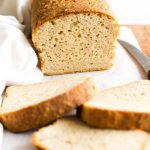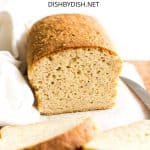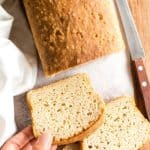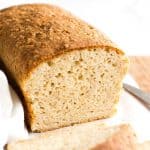Description
Incredibly tender and fluffy, this easy sorghum bread recipe is perfect for making sandwiches or toast. We love spreading this bread with homemade jam, or making avocado toast with it. Totally gluten-free and dairy-free, you’ll be making this delicious sorghum flour bread on repeat. Bake a loaf or two and freeze to enjoy homemade bread anytime!
Ingredients
Units
Scale
- 1 3/4 cups gluten-free all-purpose flour
- 1 teaspoon xanthan gum (omit if your gluten-free flour blend already includes it)
- 1/2 cup sorghum flour
- 2 tablespoons psyllium husk powder
- 1 teaspoon baking powder
- 2 1/4 teaspoons instant yeast
- 2 tablespoons granulated white sugar
- 1 teaspoon salt
- 1/3 cup sunflower oil
- 1 teaspoon apple cider vinegar
- 1 1/2 cups warm water (approximately 105 – 115F)
- 2 large eggs, room temperature, beaten
Instructions
- Grease the Pan: Grease an 8″x4″ metal loaf pan.
- Whisk Dry Ingredients: In a large mixing bowl, whisk the gluten-free all-purpose flour, xanthan gum (if using), sorghum flour, psyllium husk powder, baking powder, salt, instant yeast, and sugar together until combined.
- Add Wet Ingredients: Add the sunflower oil, apple cider vinegar, warm water, and eggs. Beat well to combine for a minute or two until you get a dough that resembles thick cake batter (the dough will be sticky and wet, but that’s completely normal for gluten-free bread dough).
- Transfer Dough to Pan: Transfer the bread dough to the previously greased loaf pan and smooth out the top with the back of a wet spatula.
- Let Dough Rise: Cover the pan with a kitchen towel and let the dough rise for 30 to 40 minutes in a warm, draft-free place until the dough has roughly doubled in size.
- Preheat Oven: While the dough rises, preheat the oven to 350F and arrange the oven rack to the middle position.
- Bake Until Golden Brown: Once the dough has doubled in size, bake it in the preheated oven for 40 to 50 minutes until the top is golden brown and the bread sounds hollow when tapped.
- Let Cool Completely: Allow the loaf to cool for 10 minutes in the pan before removing and then let it fully cool on a wire rack before slicing with a ridged knife.
Notes
- Gluten-Free All-Purpose Flour: I recommend that you use a good-quality gluten-free flour blend that is made up of lighter flours/starches such as rice flour, tapioca starch, corn starch or potato starch (as this result in a lighter and fluffier texture). I do NOT recommend using flour blends that include heavier flours such as garbanzo bean flour (as this will result in a denser texture).
- Xanthan Gum: Xanthan gum is what replaces gluten in gluten-free flours, and is necessary for binding the ingredients and giving the flour more elasticity. If your gluten-free flour blend does not already include xanthan gum, make sure you use it.
- Psyllium Husk Powder: Psyllium husk powder is basically whole psyllium husks that have been ground into a fine powder. This gives the bread more elasticity and helps it hold its shape after rising. If you don’t have access to psyllium husk powder, you can make your own by grinding whole psyllium husks in a high-speed blender or coffee grinder until very fine.
- Sorghum Flour: In this case, sorghum flour is the star ingredient as we’re making sorghum bread. However, you can also make other bread variations by substituting the sorghum flour with buckwheat flour, quinoa flour, brown rice flour, or amaranth flour in equal quantities.
- Baking Powder: Baking powder helps to give the dough a little more lift as it bakes in the oven. Make sure to use gluten-free baking powder if you’re Celiac or gluten-intolerant.
- Instant Yeast: I like using instant yeast as no activation time is required. If you don’t have instant yeast, make sure to activate the yeast beforehand.
- Sugar: The sugar is required as food for the yeast to feed on and be activated, so do not leave it out!
- Sunflower Oil: I use sunflower oil because I always have a bottle of it on hand. However, you may also use other neutral-flavored oils in equal quantities instead.
- Apple Cider Vinegar: The acidity from the apple cider vinegar in combination with baking powder creates a reaction that results in more lift in the dough. If you don’t have ACV, feel free to use other types of edible vinegar instead.
- Warm Water: Make sure to use warm water with a temperature between 105 to 115F. The yeast requires a warm environment to be activated, but if the water is too hot it may kill the yeast.
- Eggs: Eggs help to better bind the ingredients as well as give the bread more lift. I personally haven’t tried making this bread recipe without eggs or using an egg-substitute. If you do so, please let me know how it goes!
- Storing/Freezing: To store, place the bread in an airtight container and store in the refrigerator for up to 5 days. To freeze, wrap the bread in plastic wrap and then freeze for up to 3 months. Let the bread thaw completely in the refrigerator overnight before slicing.
- Prep Time: 5 mins
- Rising Time: 40 mins
- Cook Time: 50 mins
- Category: Bread
- Method: Baking
- Cuisine: American





